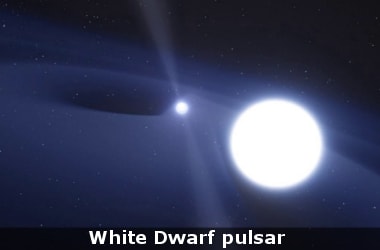
Astronomers have located an elusive white dwarf pulsar. This is the first of its kind to be discovered in the universe. It is housed in an exotic binary star system 380 light years away from Earth.
Researchers identified the star AR Scorpii (AR Sco) as the first white dwarf version of a pulsar.
Fresh data shows that AR Sco's light is highly polarised, showing that the magnetic field controls the emission of the entire system.
This is a dead-ringer for similar behaviour seen from the more traditional neutron star pulsars.
The white dwarf pulsar has eluded astronomers for over five decades.
AR Sco contains a rapidly spinning, burnt-out stellar remnant called a white dwarf, which lashes its neighbour- a red dwarf.
It does so through powerful beams of electrical particles and radiation, causing the entire system to brighten and fade dramatically twice every few minutes.
The lash of energy from AR Sco is a focused 'beam', emitting concentrated radiation in a single direction much like a particle accelerator- something which is totally unique in the known universe.
AR Sco lies in the constellation Scorpius, 380 light years from Earth, a close neighbour in astronomical terms.
The white dwarf in AR Sco is the size of Earth but 200,000 times more massive. It is in a 3.6 hour orbit with a cool star one-third the mass of the Sun, as per the study.
What is a Pulsar?- They are what is known as the “lighthouses” of the universe.
- These are rotating neutron stars that emit a focused beam of electromagnetic radiation that is only visible if you’re standing in it’s path.
- Referred to as pulsars, these stellar relics get their name because of the way their emissions appear to be “pulsating” out into space.
- Pulsars are types of neutron stars which are the dead relics of massive stars.
- They are highly magnetized, and rotating at enormous speeds.
- Astronomers detect them by the radio pulses they emit at regular intervals.